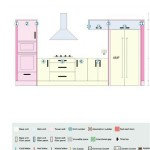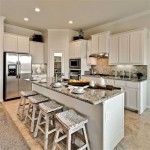Standard Height Of Overhead Kitchen Cabinets
The standard height of overhead kitchen cabinets is a crucial consideration in kitchen design. This dimension plays a significant role in functionality, aesthetics, and overall kitchen ergonomics. While there are no strict regulations dictating cabinet height, industry standards and best practices guide designers and homeowners in achieving optimal kitchen layouts. This article explores factors influencing the standard height of overhead kitchen cabinets, providing insights into achieving a comfortable and functional kitchen space.
Factors Influencing Standard Height
Several factors contribute to the standard height of overhead kitchen cabinets. These factors include:
- Ceiling Height: The height of the ceiling significantly influences the placement of overhead cabinets. In standard eight-foot ceilings, cabinets are typically installed at a height of 18 inches below the ceiling. This allows for ample headroom while providing sufficient storage space.
- User's Height: The average height of the users is another crucial factor. Ideally, the bottom of the cabinets should be easily accessible for users of varying heights without requiring them to strain or reach excessively. This ensures comfort and ease of use.
- Accessibility: The design of the kitchen should prioritize accessibility for everyone. This means considering features like adjustable shelves, pull-down cabinets, or even lower countertops. The standard height may need to be adjusted for users with mobility limitations or those who use wheelchairs.
- Aesthetic Considerations: Visual appeal is also a factor in determining cabinet height. While functionality is paramount, the cabinets' placement should complement the overall design of the kitchen, creating a cohesive and aesthetically pleasing space.
Standard Height Ranges
While there is no universal standard, most kitchen designers and manufacturers recommend a range of heights for overhead cabinets. These ranges typically fall within the following guidelines:
- Standard Height: 30-36 inches from the countertop to the bottom of the cabinet. This height is well-suited for most kitchens, offering a balance between functionality and aesthetics.
- Lower Height: 24-30 inches from the countertop to the bottom of the cabinet. This height is suitable for kitchens with lower ceilings or for users who prefer a more accessible design.
- Higher Height: 36-42 inches from the countertop to the bottom of the cabinet. This option maximizes storage space, suitable for kitchens with high ceilings or for users who desire extra storage capacity.
It's important to remember that these are general guidelines, and the optimal height for overhead cabinets can vary depending on individual needs and preferences. Professional kitchen designers can provide tailored recommendations based on specific kitchen layouts and user requirements.
Pros and Cons of Standard Heights
Choosing a standard height for overhead cabinets offers several advantages and disadvantages. It's essential to weigh these factors carefully to make an informed decision.
Pros of Standard Heights
- Functionality: Standard heights provide a balance between accessibility and storage space. They allow for comfortable reaching while maximizing the cabinet's storage capacity.
- Aesthetics: Standard heights contribute to a visually cohesive and balanced kitchen layout, ensuring the cabinets blend seamlessly with other design elements.
- Cost-Effectiveness: Standard height cabinets are readily available and usually more affordable than custom options, which can be crucial for budget-conscious homeowners.
Cons of Standard Heights
- Potential for Inconvenience: Standard heights may not be comfortable for all users, particularly those with shorter stature or limited mobility. Reaching for items in higher cabinets may be difficult, leading to inconvenience and frustration.
- Limited Storage: Standard heights may not accommodate large or bulky items if the space is limited. If additional storage is required, consider supplementing standard cabinets with specialty cabinets or other storage solutions.
- Lack of Customization: Standard heights may limit customization options, especially if unique design preferences or functional requirements necessitate different cabinet placements.
Overhead Kitchen Cabinets Dimensions Google Search Measurements Wall Cabinet Sizes
N Standard Kitchen Dimensions Renomart
Kitchen Measurements
Know Standard Height Of Kitchen Cabinet Before Installing It
Know Standard Height Of Kitchen Cabinet Before Installing It
Diy Kitchen Quality Designer Cabinet Dimensions Cabinets Height Measurements
What Should You Know About Kitchen Cabinetry Handles And More
Standard Kitchen Cabinet Dimensions For Your Homee Design Cafe
Standard Upper Cabinet Height Bulacanliving
What Are The Perfect Kitchen Dimensions Standard Size








